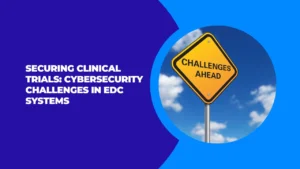Physical Address
304 North Cardinal St.
Dorchester Center, MA 02124
Physical Address
304 North Cardinal St.
Dorchester Center, MA 02124

As clinical research becomes increasingly digital, electronic data capture (EDC) systems have revolutionized how patient data is collected, managed, and stored.
These systems streamline workflows, reduce manual errors, and make real-time data sharing possible across institutions. However, the digitization of such sensitive medical data also introduces significant cybersecurity vulnerabilities.
Protecting the integrity, confidentiality, and availability of clinical trial data is no longer just a technical issue, but a regulatory, ethical, and safety concern.
In recent years, EDC systems have largely replaced paper-based records in clinical trials. Researchers now rely on centralized platforms to input, monitor, and analyze everything from patient enrollment details to drug efficacy reports. While this digitization improves speed and accuracy, it also creates attractive targets for cybercriminals.
Health data is particularly valuable on the black market, and clinical trials often involve highly sensitive, unpublished information, including personally identifiable patient data, proprietary drug information, and medical device development plans. A breach could compromise patient privacy, delay treatments, or even lead to flawed scientific conclusions.
EDC systems are only as secure as the frameworks and practices users rely on. Some of the most common cybersecurity risks in clinical trial data include:
Since clinical trials often span multiple sites and countries, the complexity of ensuring secure data transmission and access increases. Regulatory differences and inconsistent adherence to cybersecurity best practices only heighten the risk.
While EDC platforms are built with security protocols, human behavior often remains the weakest link. Even a well-designed system can be compromised by an untrained user clicking a malicious link or failing to update software.
Clinical researchers and site coordinators, many of whom come from non-technical backgrounds, must be educated on safe data handling practices.
Training should cover basic cybersecurity hygiene, including secure password creation, two-factor authentication, recognizing phishing attempts, and securely sharing data across networks. Ongoing refreshers and institutional support can ensure these lessons are maintained over time.
When cybersecurity fails, data and patient safety can be at risk. Even minor disruptions or inaccuracies in data systems can lead to serious consequences in patient care and trial outcomes. A single missing data point caused by a breach or malfunction might invalidate results or delay life-saving treatments.
Ensuring that EDC systems are not only accurate but also secure is essential to preserving both scientific integrity and patient trust. The safety net must include regular audits, incident response protocols, and close collaboration between clinical, IT, and compliance teams.
Data security is not only a standard practice, but is often a legal requirement. Clinical trials must comply with a complex web of regulations depending on the location of the research and the type of data collected. Some of the most widely referenced frameworks include:
Failing to meet these standards can result in fines, halted trials, or loss of reputation; costs that far outweigh the price of robust cybersecurity investments.
As the scale and complexity of clinical trials grow, the resilience of EDC systems must grow with them. Some best practices for enhancing cybersecurity in these platforms include:
It’s also critical for EDC vendors to maintain transparency and collaboration with research institutions. Building trust requires open communication about security measures, known vulnerabilities, and response capabilities.
For too long, cybersecurity in clinical research has been treated as a secondary concern; an IT box to check off after the “real” work of trial design and execution. However, as digital systems become central to modern research, securing them is inseparable from the core mission of improving patient outcomes.
The conversation around data protection must move beyond compliance and into culture. Researchers, sponsors, and software vendors must all understand that patient safety, scientific accuracy, and ethical responsibility are directly tied to digital security.
The future of clinical research depends on the digital tools that enable it. As EDC systems become more sophisticated and trials increasingly rely on remote data collection, the stakes for cybersecurity only rise.
Ensuring that these systems are secure, resilient, and ethically managed is more than just an IT challenge—it’s a collective responsibility that touches every aspect of modern medicine.
By investing in the proper infrastructure, training, and collaboration, we can build a future where technology advances patient care without compromising privacy or integrity. That’s not just good science, it’s good ethics.